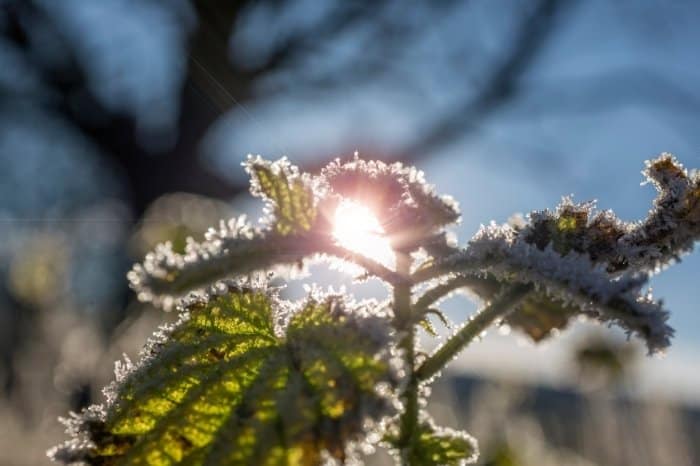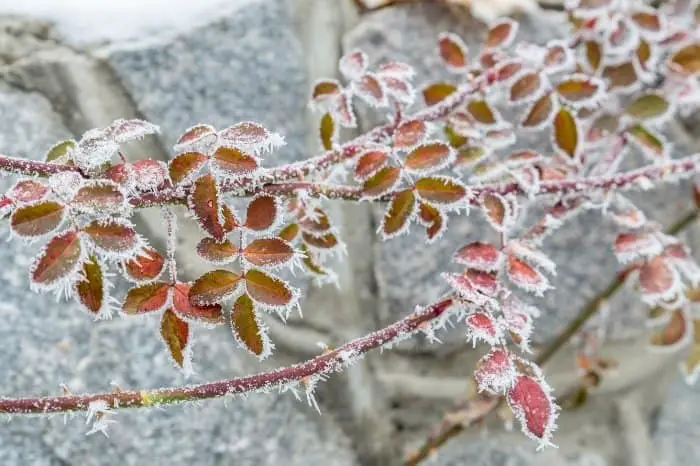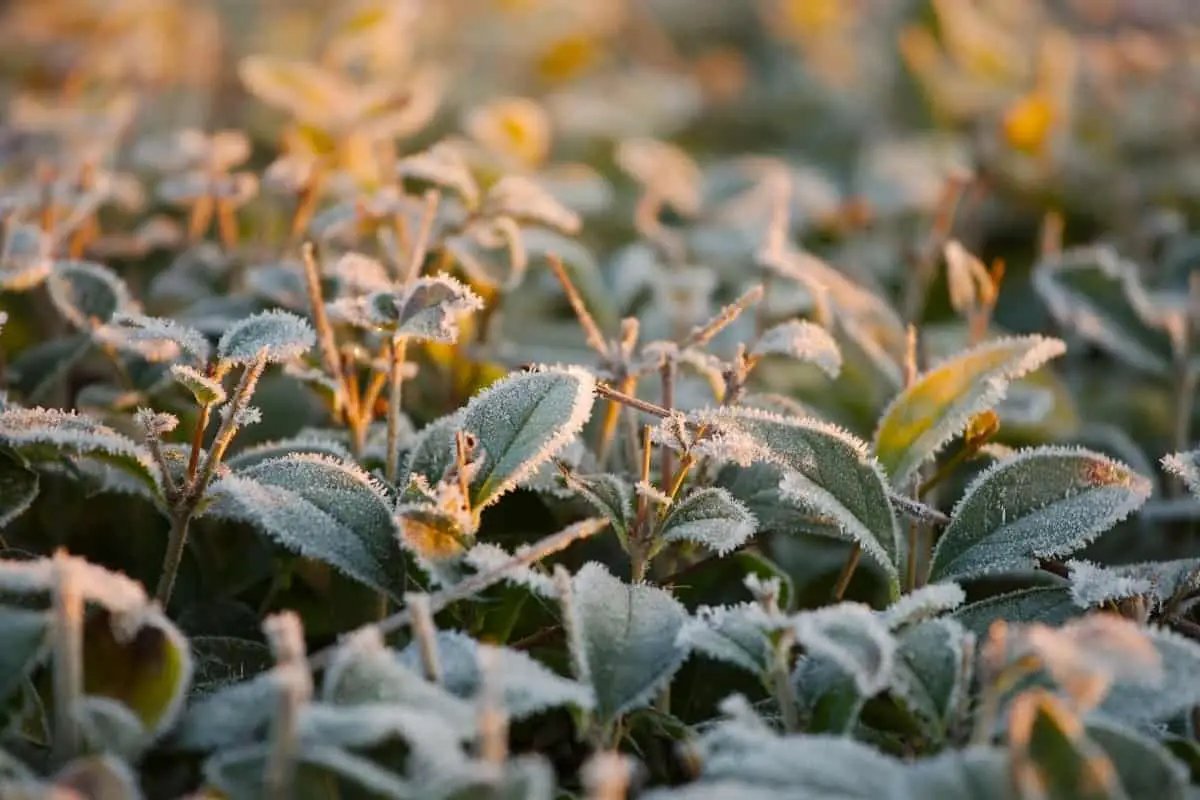Last Updated on December 15, 2022 by Griselda M.
Should I cover my plants at 39 degrees or what is the right time to shield them from frost and freezing temperatures? This is one of the frequently asked questions by gardeners when the cold season is setting in. We will look at it today and learn more about how to protect plants from frost.
When the weather reports predict frost and overnight lows that are near freezing, what should you do? You should remain calm and think ahead instead of panicking about the garden that you love so much. Keep in mind that frost is different from the freeze. And, there are several strategies you can use to help protect your plants from frosty temperatures.
Still a blessing in disguise, plants like carrots, parsnips, and beets only get sweeter in flavor after a frost. To better understand what steps to take when freeze warnings threaten, you need to know the point at which the greenery fades to frost-burned-brown.
Should I Cover My Plants At 39 Degrees?
Most plants begin to freeze when temperatures remain at 28 degrees for more than five hours. Seedlings and their tender leaves often give up when the temperatures go as low as 32-33 degrees F. Tropical plants can tolerate temperatures as low as 40 degrees F.

At What Temperature Do I Need To Cover My Plants?
Right from the time, the temperatures begin to freeze, be on the lookout. When the temperature reaches around 28 degrees F for five consecutive hours, protect your plants by covering them with sheets, blankets, towels, cardboard, or a tarp. Cover the plants before dark to trap them in warm air and don’t allow the coverings to touch the foliage. Make sure you anchor your coverings in case the winds threaten.
Remove the coverings in the morning when the temperatures rise and the frost dissipates. The heat from the sun can build under the solid coverings killing the plants from high temperatures.
The Right Steps To Follow If You Choose To Cover Your Plants At 39 Degrees Or Lower
Know Your Frost Dates
This is the first and most important thing to know. Keep in mind the first and last frost date. As the temperatures begin to cool down, the first day of the year that a frost occurs is considered the first frost day.
As the temperatures begin to cool, a week or two later, the first freeze date of the year sets in. This is what kills most plants. Due to climate change, these dates will not always be the same, you will have to wait and see what dates the frost is appearing each year.

As spring approaches, the temperatures begin to warm up. On the last day of the year, you can expect a frost is an average last frost date.
Always be diligent to check the weather report regularly or set up a weather app alert to keep an eye on the overnight lows.
Assess The Frost
Don’t just check the beginning of low temperatures but check also the length of time they remain at a low or freezing point. Indeed, lower temperatures damage plants but very cold temperatures that last several hours are much harder on a plant than an hour or less of low-freezing temperatures.
Keep in mind that along with evaluating the weather report; know how long the temperatures remain at the same point. There are also important things you need to find out as shown below
-
Frost Advisory – This is the period when the temperatures are expected to fall up to 36 degrees to 32 degrees Fahrenheit.
-
Freeze Warning – This is a warning issued when there is an 80% chance that the temperatures will hit 32 degrees Fahrenheit or lower.
-
Light Freeze – This is around 29 to 32 degrees Fahrenheit and will kill tender plants.
-
Moderate Freeze is around 25 to 28 degrees Fahrenheit and is widely destructive to most vegetation.
-
Severe Or Hard Freeze – This is from 25 degrees Fahrenheit and colder causing heavy damage to most plants.
Valibe Plant Covers Freeze Protection 10 ft x 30 ft
Assess The Plants And Prioritize
Some plants in your garden are considered hardy as they handle a light frost. However, those tender ones will be injured or die from freezing temperatures.
Hardy plants will do fine even without protection from the frost. The plants you should prioritize are the ones with tender leaves to protect them before frost harms them.
Prioritize your time, energy, and money meaning the plants that are most valuable to you should be covered first. Cover plants that are about to mature first so you don’t lose the harvest. You have worked so hard to grow those plants, you deserve a good harvest.
What Actions To Take Besides Cover Your Plants At 39 Degrees?
-
Water Your Plants. If you never knew, water acts as an insulator. Plant cells that are plump with water can withstand cold damage easily. In addition, moist soils tend to stay warmer than dry soil. Give your plants a good soaking before freezing temperatures set in to help protect your plants.
-
Cover Your Plants. The soil is a great insulator and thermal regulator that’s why the root vegetables can handle a couple of frosts. Cover tender plants with commercial frost cloths to protect your plants. Old bed sheets, tarps, burlap, or even plastic buckets placed over baby plants in early spring can protect plants from frost. Be sure to stake the material down so the wind doesn’t blow it off. The cover should go all the way to the ground to maximize insulation and keep the heat from the soil close to the plants.
-
-
Note: If you use a plastic sheet, keep it from touching any foliage or fruit. The cold can transfer through the plastic and burn the plant. For small plants, you can cover them with an inverted bucket or flower pot. Remember to remove the cover when temperatures rise during the day.
-
-
Harvest Early. If your plants are nearing harvesting, you can go ahead and harvest them. Most vegetables and fruits will ripen at home after being harvested. Tomatoes, apples, peaches, pears, etc. will continue to ripen off the plant. Once you harvest them, place them in a paper bag in a dark, cool part of your house and check on them a couple of times a week. Enjoy your fruits and vegetables as they ripen and always remove anything moldy or rotting.
What Temperature Should You Cover Vegetable Plants?
Frost can occur at temperatures above freezing, and hence the decision will depend on the type of vegetable plant. Some plants are more frost sensitive than others. My general advice would be to start implementing frost mitigation measures when you are likely to be experiencing temperatures that are 10 or so degrees away from freezing. Official temperature measurements are taken 4 or so feet above the ground, hence temperatures at ground level tend to be lower.
In other words, we know that at 32°F your plants will be frozen – however, due to the nature of frost, you can experience frosts at temperature predictions closer to 39°F if there is no wind as the chances are the temperature at the ground will be below freezing.
How Do I Protect My Plant Roots From Frost?
If you are moving out of winter into spring, you can often help to warm your soil a bit and allow it not to cool too much at night by applying a layer of mulch. I believe in heavy mulching, and by applying a thick layer of mulch over the soil there is an amazing insulating effect that this mulch has. The problem with mulch is that it can also keep heat out of the soil. Luckily modern technology has a solution.
In addition to keeping the heat in the soil, the process of organic matter breaking down actually releases some heat. You can consequently actually warm your soil if you apply a thick layer of mulch that then undergoes a composting process. It is useful when it is cooler to cover this much with a black mat such as this one. During the day, the mat absorbs heat and heats the mulch enabling the composting process to gain momentum, at night this heat is trapped in the mulch and continues generating and keeping your soil warm.
How do I protect my garden bed from frost?
In this case, we are mainly looking at early spring cold snap frosts. There is not much you can do at the end of the season – for those frosts, it is just a waiting game – you are doomed eventually. In spring, we need to try and protect plants when we have late cold snaps and so on.
I have over the years managed a few useful tricks that have saved my plants in late spring cold snaps! Here are a few that you may wish to try.
Cloches – when it gets looks like there is a cold snap coming you can put old plastic tubs and similar things over your plants – or you can buy a cloche.
If you have a large bed of plants, and it is a bit difficult to cover individual plants you can use a cloche tunnel such as this one.
I am still a big fan of this method of building up a compost layer in between rows of plants – if you dig a few feet deep and heap soil into large mounds and then fill the gaps between rows with grass clippings and manure and then another layer of leaves and so on, you can build up an organic compost heat source. I have managed to start plants way earlier than normal using this method – if you look at maize the seeds will germinate at about 54°F or so. The seedlings that emerge at these low temperatures are pretty pathetic, however.
I have managed to get maize to start much earlier (weeks) by using the compost heating of rows technique. You can raise your soil temperature by at least 10°F by building compost heaps into your rows of beds. The great thing about this is that as the seasons warm up, your compost layer feeds your plants and you can keep feeding this compost layer then in autumn you dig the two layers into each other and make ridges again and now your soil for the next season is full of really good compost.
And last but not least – A fan!! Yes, if you encourage the mixing of air, you can often prevent frost. An oscillating fan such as this one will work very well. It will cause the air to mix and will result in air layers not getting as cold. Cold air is heavy and settles to the ground – if you mix the air around a bit, it often helps stop frost. For years I had a big AEG fan similar to the one in the link that I put outside in my garden. Eventually, it succumbed to the moisture and died. I have since covered the frost-prone parts of my garden in shade cloth so the fan is not needed anymore.
How do I protect my spring flowers from freezing?
If you have planted them out already, I would suggest cloches. If you have a large bed, you may find that this tunnel cloche works better. I personally keep my spring flowers in pots in my greenhouse until I am 100% sure that all frosts have passed. I just do not like taking chances and finding my seedlings burnt off on the ground in mushy black messes.
How do I protect my plants from spring frost?
I believe in using cloches, and a mulch layer. The mulch layer, if covered in black mat material will generate heat and keep the plant roots warm. The cloche stops the leaves from freezing.
You get a black frost – your plants are dead no matter what you do – and a light frost -they have little prickles of ice on the leaves. Often, if you suspect a light frost, go out to your garden and sprinkle your plants with water before the sun hits the leaves – this can help them not die as well. Try to keep sunlight off the leaves for an hour or so after watering.
How do I protect my plants from sudden freeze?
If there is a risk of a really sudden cold snap I have done some crazy things over the years! I once planted out a lot of peppers and was convinced the last frost of the year was gone, and then we had this crazy cold snap! I went out and actually put a fan heater in my garden!! I put the heater in a dog kennel with the fan facing outwards over the garden, and it actually worked! A little bit of heat goes a long way when it comes to stopping frost.
My general advice would be to plant things after there are any risks, and use cloches. The cloche not only protects your plant against the cold, but it also acts as a little greenhouse keeping your plants warm and toasty during the day! There is always that ravenous slug or snail that somehow manages to emerge in spring and eat your seedlings – this keeps that creature out as well.
How Do I Keep My New Plants From Freezing?
Keep them plants indoors as long as you can! If you have seedlings from a nursery, instead just buy them a week or two later. There is no big difference between a plant that is planted in the high risk of a cold snap spring patch, and a few weeks later -they catch up. I have over the years always tried to push boundaries, and have learned the hard way that you can probably bring your planting back a maximum of one to two weeks using a cloche or a cloche tunnel.
If you want to be fancy, invest in a small greenhouse that has polycarbonate sheeting (insulation), and put a small heater such as this in it. This will allow you to grow your squash and peppers and other cold-sensitive plants for a few weeks into spring, and plant them in the ground when there is no risk of a cold snap. This way, for a few hundred dollars, you can ensure a crop that is worth way more than the cost of the equipment you invest to make sure it succeeds.
What Temperature To Cover Plants Conclusion
To avoid facing the devastating effects of frost, you can choose to plant early. Even if you are ready to cover your plants at 39 degrees or less, you can avoid all the work that comes with covering. This way you will avoid facing frost and harvest your crops in good time.
Good Luck!
Caroline is a gardener who loves to get down to the nitty–gritty of gardening. She proudly proclaims herself as a ‘dirt worshipper‘ and can often be found deep in the garden, covered in soil and singing to her plants. As a self–proclaimed ‘plant whisperer‘, Caroline believes that plants need love and attention just like any other living thing, and she loves to give them both. When she‘s not tending to her garden, you can often find her researching the latest gardening trends, or teaching others how to make their gardens thrive



